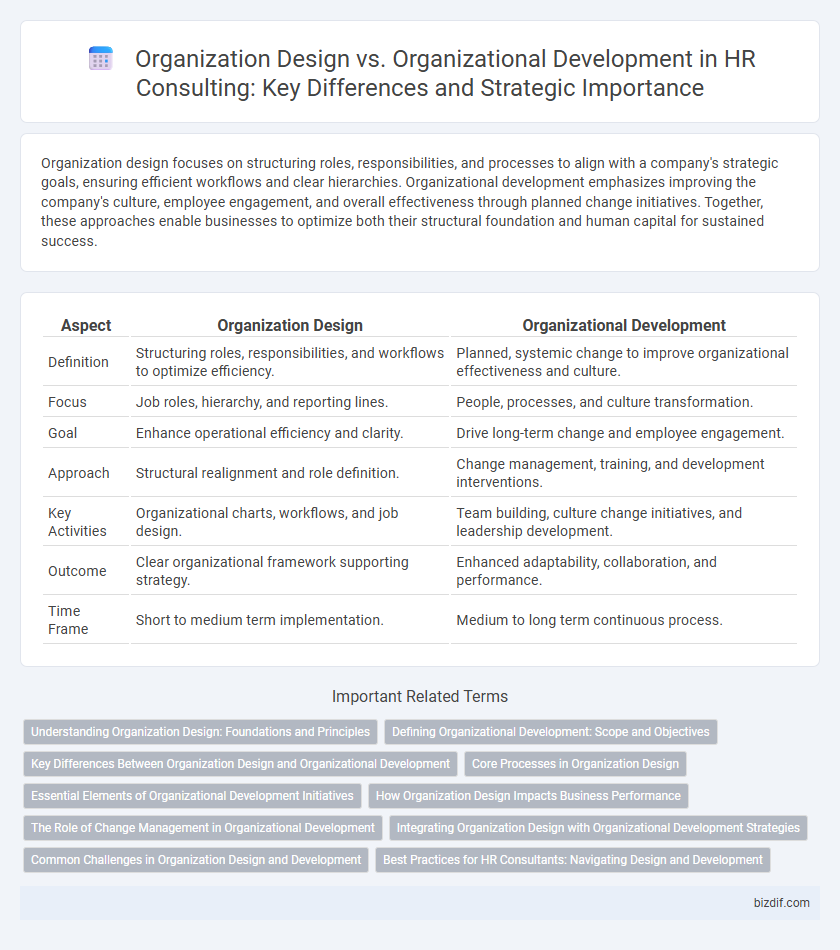Organization design focuses on structuring roles, responsibilities, and processes to align with a company's strategic goals, ensuring efficient workflows and clear hierarchies. Organizational development emphasizes improving the company's culture, employee engagement, and overall effectiveness through planned change initiatives. Together, these approaches enable businesses to optimize both their structural foundation and human capital for sustained success.
Table of Comparison
| Aspect | Organization Design | Organizational Development |
|---|---|---|
| Definition | Structuring roles, responsibilities, and workflows to optimize efficiency. | Planned, systemic change to improve organizational effectiveness and culture. |
| Focus | Job roles, hierarchy, and reporting lines. | People, processes, and culture transformation. |
| Goal | Enhance operational efficiency and clarity. | Drive long-term change and employee engagement. |
| Approach | Structural realignment and role definition. | Change management, training, and development interventions. |
| Key Activities | Organizational charts, workflows, and job design. | Team building, culture change initiatives, and leadership development. |
| Outcome | Clear organizational framework supporting strategy. | Enhanced adaptability, collaboration, and performance. |
| Time Frame | Short to medium term implementation. | Medium to long term continuous process. |
Understanding Organization Design: Foundations and Principles
Organization design focuses on structuring roles, responsibilities, and workflows to align with strategic goals, emphasizing clarity in reporting lines and efficient resource allocation. Key principles include differentiation, integration, and formalization to create adaptable yet coordinated systems that enhance performance and agility. Understanding these foundations allows HR consultants to tailor organizational architecture that supports innovation, collaboration, and sustainable growth.
Defining Organizational Development: Scope and Objectives
Organizational development (OD) encompasses planned, systematic efforts to improve a company's effectiveness through interventions in its processes, structures, and culture, targeting enhanced employee engagement and organizational agility. The scope of OD includes leadership development, change management, team building, and fostering continuous learning to drive sustainable performance improvements. Its primary objective is to align organizational capabilities with strategic goals by facilitating adaptive change and enhancing collaborative work environments.
Key Differences Between Organization Design and Organizational Development
Organization design focuses on structuring roles, hierarchies, and workflows to optimize efficiency and align with business strategy, while organizational development emphasizes cultural change, employee engagement, and long-term behavioral improvements. Key differences include organization design's tangible outputs like org charts and reporting lines versus organizational development's intangible outcomes such as leadership effectiveness and team dynamics. The former addresses structural issues, whereas the latter targets people-related processes and change management for sustained growth.
Core Processes in Organization Design
Core processes in organization design focus on structuring workflows, roles, and decision-making pathways to enhance efficiency and alignment with strategic goals. These processes include defining key activities, streamlining communication channels, and establishing clear reporting relationships to optimize operational performance. Effective organization design ensures that core processes support agility, scalability, and employee collaboration within the company.
Essential Elements of Organizational Development Initiatives
Organizational development initiatives focus on essential elements such as culture transformation, employee engagement, leadership development, and continuous feedback systems to drive sustainable change. In contrast, organization design primarily deals with structuring roles, hierarchies, and workflows to align with strategic goals. Successful organizational development integrates these elements to enhance overall effectiveness, adaptability, and performance.
How Organization Design Impacts Business Performance
Organization design directly influences business performance by structuring workflows, roles, and communication channels to enhance efficiency and agility. Effective organization design aligns resources with strategic goals, enabling faster decision-making and improved responsiveness to market changes. Optimized organizational structures increase employee engagement and collaboration, driving innovation and sustaining competitive advantage.
The Role of Change Management in Organizational Development
Change management is a crucial component of organizational development, focusing on guiding employees through transitions to achieve strategic goals effectively. It involves structured processes and tools that help align company culture, workflows, and leadership to adapt to evolving business environments. Integrating change management into organizational development ensures sustainable growth and improved employee engagement during transformative initiatives.
Integrating Organization Design with Organizational Development Strategies
Integrating organization design with organizational development strategies enhances structural alignment and fosters sustainable change, boosting overall workforce effectiveness. This integration involves aligning roles, processes, and technology within a dynamic framework that supports continuous learning and adaptability. Leveraging data-driven insights in both disciplines ensures optimized workflows and a resilient organizational culture that drives long-term business success.
Common Challenges in Organization Design and Development
Common challenges in organization design and organizational development include resistance to change, misalignment between structure and strategy, and unclear roles and responsibilities. These issues often lead to reduced employee engagement and inefficiencies, hindering overall business performance. Addressing these obstacles requires careful analysis of organizational culture, continuous communication, and iterative adjustments to design and development initiatives.
Best Practices for HR Consultants: Navigating Design and Development
HR consultants excel by integrating organization design and organizational development to drive sustainable performance improvements. Best practices include conducting thorough workforce analyses, aligning structure with strategic goals, and fostering continuous change management initiatives. Leveraging data-driven insights and employee feedback ensures optimized workflows while nurturing a culture of adaptability and innovation.
Organization design vs organizational development Infographic

 bizdif.com
bizdif.com